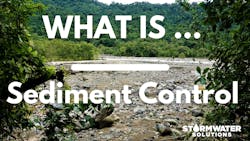Sediment control can be defined as practices designed to prevent or minimize loss of eroded soil at a site.
According to the Washtenaw County Water Resources Commissioner (WCWRC), sediment is the product of uncontrolled erosion.
The U.S. Environmental Protection Agency (EPA) lists sediment as the most common pollutant in rivers, streams, lakes and reservoirs.
Why is sediment control important?
The Minnesota Stormwater Manual states that “sediment carries nutrients and pollutants that degrade water resources and harm aquatic wildlife.”
Thus, sediment control is important because by minimizing the loss of eroded soil at a site, there is a lower chance of pollution and damage to the environment. Sediment control practices can limit the amount of sediment that is carried into lakes, streams and rivers by stormwater runoff.
Furthermore, the impacts of erosion and sedimentation include: “loss of fertile topsoil, filling of lakes and streams, increased flooding, damage to plant and animal life and structural damage to buildings and roads.”
Additionally, excess sediment can harm the equipment used in the drinking water treatment process, increasing the cost of treating drinking water. In fact, with excess sediment, drinking water may also have odor and serious taste problems.
According to EPA, “the most concentrated sediment releases come from construction activities, including relatively minor home-building projects such as room additions and swimming pools.”
How do you control sediment?
There are many ways to control sediment, including sediment basins, ripraps, sediment traps, silt fences, filter bags and more.
The most common methods of sediment control are sediment basins, sediment traps, and silt fences.
According to The Minnesota Stormwater Manual, “sediment basins consist of a principal spillway, dewatering device, and an emergency (overflow) spillway.” A principal spillway conveys the treated stormwater away from the site and discharges it. It operates by using a vertical riser that controls basin water levels and an outlet pipe, thereafter, using a dewatering device to release the runoff over time, so the sediment can settle out over time.
With sediment traps, these are “small, temporary ponding basins that treat stormwater by allowing sediment particles to settle out of the water,” states the EPA. These traps are usually located in a drainageway or other point of discharge from a construction site, allowing them to capture stormwater before it flows outward.
Silt fences are also helpful for controlling sediment, as they filter sediment from runoff by allowing water to pass through a geotextile fabric or by creating a pool to allow sediment to drop out of the water column.
Without these sediment control measures, repairs to fix the damage of eroded soil at a site can be costly.
What is the difference between erosion control and sediment control?
According to the University of Nebraska-Lincoln Institute of Agriculture and Natural Resources, the difference between erosion control practices and sediment control practices are that erosion control practices are “typically designed to prevent detachment and transportation of soil particles while sediment control is designed to trap eroding soil onsite.”
Ideally, controlling erosion is key to controlling sediment after erosion occurs.
Another point to note is that erosion control aims to reduce and prevent the erosion of soil from repetitive impacts such as rainfall, while sediment control deals with displaced or shifted sediment, according to Ecospill.


